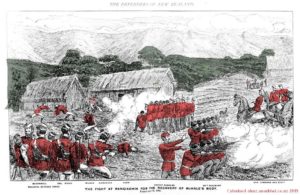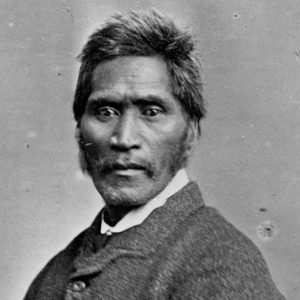1864: Rangiaohia
April 3, 2019
By AHNZ
I n February 1864 the Waikato War was in full swing. General Duncan Cameron adopted a scorched earth strategy to capture and destroy the enemy’s chief sources of food supplies. By stealth, Cameron led his men quietly past the Paterangi Line where the Kingite Maori forces were massed. At dawn on Sunday 21st February Cameron’s army made a surprise attack on Rangiaohia, the unfortified village that supplied food to the Paterangi garrisons.
n February 1864 the Waikato War was in full swing. General Duncan Cameron adopted a scorched earth strategy to capture and destroy the enemy’s chief sources of food supplies. By stealth, Cameron led his men quietly past the Paterangi Line where the Kingite Maori forces were massed. At dawn on Sunday 21st February Cameron’s army made a surprise attack on Rangiaohia, the unfortified village that supplied food to the Paterangi garrisons.
Rangiaohia (Modern Politically Correct te reo retcon: Rangiaowhia) was soon overcome by skirmished fighting and the capture of Kingite sniper positions. Cameron had the last resistance pinned down to the basement of a couple of thatched houses, all else captured, killed, or had fled.
But these last hold-outs put up a very brave fight, refusing to surrender their combustible thatched fortress. They keep shooting back at the overwhelming Imperial forces surrounding. A Cavalryman, a soldier, a Colonel, a Corporal, a Ranger- all killed by the hold-outs!
Rather than lose more men it would be a sound tactic to simply set this shack alight since, after all, burning houses was the order of the day. This may have been done but history also records the fire may have been ignited by the gunfire. It is now, and not before, that one of these snipers offers surrender to join the other settlement prisoners. He is an old man. The officers wanted to take him alive but in the excitement he was gunned down by the unforgiving soldiers.
Revisionist Analysis
I don’t mind revisionism one bit! Anarchist history implies it. But we all must insist that it is based on evidence! Dame Susan Devoy, Vincent O’Malley, and even Jock Philips have piled on to a narrative that says Rangiaohia was a genocide where women and children were burned to death!
There is no evidence colonial troops had fired on women and children at Rangiaowhia at all. Why do people keep saying it happened? Historian Jock Philips has had to back-peddle his claim to: ‘aggrieved Maori “certainly believe so.”‘ Yet he’s still calling one old man allegedly being shot “appalling genocide.” Possibly he is being mischaracterised in the article? I’ve found Jock to be much smarter than this in his other work but this time he barely avoided being censored by the Broadcasting Standards Authority for talking rot.
Vincent O’Malley has made the same claims to plug his book on the Waikato War: Inglorious Dastards: Rangiaowhia raid and the ‘great war for New Zealand. No evidence in this Listener article either, just the same tap-tap-tap of pressure to revise history.
O’Malley
 Here is the page (click to enlarge) from Vincent O’Malley’s new book laying the basis for the claim that innocent Maori women and children were slaughtered at Rangiaowhia settlement by Colonial forces during the Maori Wars.
Here is the page (click to enlarge) from Vincent O’Malley’s new book laying the basis for the claim that innocent Maori women and children were slaughtered at Rangiaowhia settlement by Colonial forces during the Maori Wars.
It’s a bit like the Maori Wars Nuremberg trials to hear these defeated rebel leaders, Wiremu and Wiremu, confessing their war crimes which were ‘of the nature of murder.’ How can they excuse such conduct? The usual excuse will do. It’s that the other side, Colonial Forces, were first and worst at degenerate warfare.
 How are we to test this biased account? Surely we’re not to simply swallow it because we believe Tamihana will rebel and murder but he will NOT lie to Colonial powers? Especially when so much land was at stake which he was seeking the moral authority to get back from Government?
How are we to test this biased account? Surely we’re not to simply swallow it because we believe Tamihana will rebel and murder but he will NOT lie to Colonial powers? Especially when so much land was at stake which he was seeking the moral authority to get back from Government?
He wasn’t there that day to know that this unfortified settlement refused to surrender and in what circumstances they hopelessly resisted. Or, why they did what they did.
What really happened at Rangiaowhia in 1864 may be as described on O’Malley’s pages. But we can’t assume so by ignoring all other accounts except this biased old man’s, Tamihana’s, testimony.
—
image ref. Colourised a bit by AHNZ 2019; Alexander Turnbull Library; NZ History.gov
Portrait ref. Alexander Turnbull Library, 1/2-053942-F
Text ref. The Great War for New Zealand (2016)
Note: I must include the spelling ‘Rangiaowhia’ so revisionists can find this post but my preference is to use ‘Rangiaohia’ rather than conform to yet another ‘Aotearoa’ retcon.
Update: Actually, Rangiaowhia is the spelling used of the time so that’s perfectly legitimate. Rangiaohia is the spelling from c.1900. Modern revisionist historians trying to Maori Macron up their writing have, in this case, solid ground to stand upon.
Update 2023: “Rangiaowhia has been spelled in a variety of ways, ranging from the curious “Rangahaphia” in one of the Auckland papers of 1851 to “Rangiaohia” and “Rangiawhia.” The old men of Ngati-Maniapoto pronounce and write the name as spelled in this book.” – The Old Fronteir- Te Awamutu the story of the Waipa Valley, James Cowan (1922) If it’s good enough for the old Maoris and James Cowan then that’s the spelling I’ll be using from here on.
4 thoughts on "1864: Rangiaohia"
Leave a Reply
 Like Comment Share
Like Comment Share






Boy, if ever there was an engagement that the Maori feel bitter about it is this one.
Marmaduke Nixon was beloved of his troops. His being shot from the resisting whare who had been offered surrender would have resulted in only one outcome for those inside. Especially when further troopers were shot.
There is a video on youtube of the commemoration of the plaque marking this event. It has the NZ Army, politicians and academics in obedient attendance all infused with solemn guilt. The plaque reads ‘This stone is a memorial to the atrocities suffered by Ngati Apakura, Ngati Hinetu and others at Rangiaowhia on the 21st of February, 1864’
Atrocities!, what a joke, you have to get into the history of what Te Kooti did to know what atrocities really were.
Yes indeed. That’s State History for you. Plenty of websites and new books, well funded, to tell it that way. One little Anarchist page to keep it real.
The Church which was allegedly set on fire, burning women and. Hildren inside, strangely was able to appear in photographs some years after.
Revisionist historians bend backwards to suppose that some house or shack was maybe referred to colloquially as a “church.” Of course, that’s a claim that absence of evidence is evidence of absence.